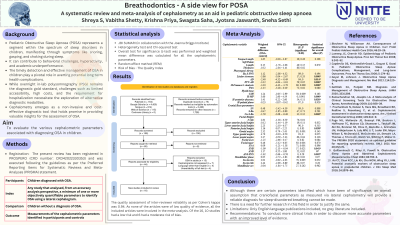Other
151 - Breathodontics - A side view for POSA


Shreya S, BDS
Postgraduate student
A B Shetty Memorial Institute of Dental sciences
A B Shetty Memorial Institute of Dental Sciences
Mangalore, Karnataka, India- JJ
Jyotsna Jaswanth, BDS
A B Shetty Memorial Institute of Dental sciences
- KP
Krishna Priya, BDS
A B Shetty Memorial Institute of Dental sciences
- SS
Swagata Saha, BDS
A B Shetty Memorial Institute of Dental sciences
- SS
Sneha Sethi, MDS
Adelaide Dental School
- MR
Manju R, BDS, MDS, PhD
Head of the Department
A B Shetty Memorial Institute of Dental Sciences
Mangalore, Karnataka, India
Presenting Author(s)
Co-Author(s)
Program Director(s)
Purpose:
Obstructive sleep apnea (OSA) is part of a spectrum of sleep disorders causes snoring, gasping, and choking while sleeping. In children, OSA can also lead to behavioural issues, hyperactivity, and poor academic performance. Thus, early identification and management of OSA in children is crucial in preventing long-term health problems. The gold standard test for diagnosis is an overnight in-lab polysomnography (PSG). However, due to constraints such as lack of accessibility, high expenses incurred, as well as the need for hospitalization, alternative diagnostic tools are needed. Cephalometry is a non-invasive, low-cost diagnostic tool that may offer useful information in the evaluation of OSA. The present systematic review and meta-analysis aimed to evaluate the various cephalometric parameters associated with diagnosing OSA in children.
Methods:
A structured literature search was performed using the search engines PubMed, Scopus, Web of Science, Cochrane, and Google scholar from inception till July 2022. The weighted mean difference (z-test) was calculated using a random effects method (REM).
Results:
16 studies were included in the review and meta-analysis was executed for each cephalometric parameter. The parameters of significance (P < .05) in Pediatric OSA with lower heterogeneity were associated with McNamara’s and Linder-Aronson’s analysis, the hyoid bone position, a retrognathic mandible, and an acute cranial base angle.
Conclusions:
Certain parameters in craniofacial morphology may be reliable diagnostic parameters. Further long-term studies are needed in order to shed more light in this area.
Identify Supporting Agency and Grant Number: Research supported by no external source.

.jpg)